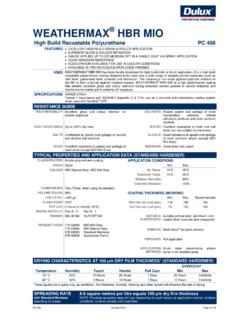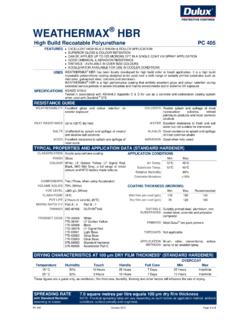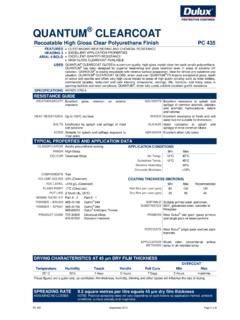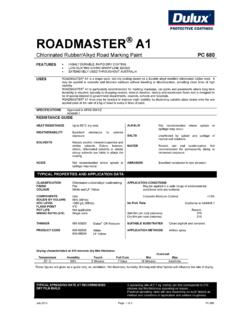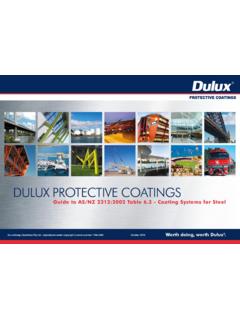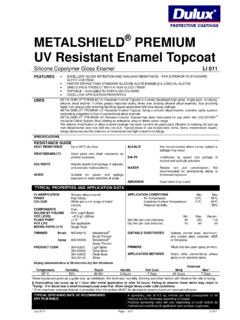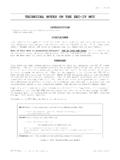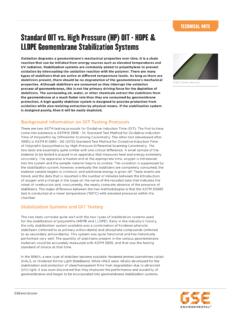Transcription of Problems with Concrete - Efflorescence 1.3
1 PPrroobblleemmss wwiitthh CCoonnccrreettee -- EEfffflloorreesscceennccee Problems With Concrete - Efflorescence Sep-09 Page 1 of 2 What is Efflorescence ? Efflorescence appears as a white deposit of mineral salts on face of Concrete walls and/or floors. Efflorescence usually appears in underground car park areas and other subfloor areas. Efflorescence is caused by moisture ingress. As the moisture enters and moves through the wall or floor, it dissolves mineral salts present in the cement. This mineral salt solution eventually finds its way to the surface of the Concrete .
2 As the water evaporates, it leaves behind a white deposit of mineral salts on the surface. Efflorescence is not to be confused with laitance, which is the appearance of a loose, powdery deposit of cement powder and sand fines on the surface of Concrete . Laitance is caused by excess water in the Concrete mix, by poor Concrete curing practice ( failure to apply wet hessian, wet sand or a curing membrane or, at the very least, plastic sheet over the wet Concrete and thus allowing the Concrete surface to dry out prematurely) and by over-trowelling. How Serious Is The Efflorescence Problem?
3 Normally, excess water in the Concrete mix will eventually evaporate and the Concrete will achieve equilibrium in water content. Ideally that should be <10% as measured with a standard moisture meter. Concrete is generally left to fully cure for at least 30 days, but may be significantly longer, depending on the moisture content of the Concrete and ambient conditions. If, however, Efflorescence is present, then this is evidence that moisture ingress is occurring from external sources, and therein lies a serious problem. The Efflorescence will progressively worsen with time.
4 In severe cases, the salt solution can travel down the face of the wall, leaving a trail of mineral salts. Other Problems are discoloration of the Concrete , the proliferation of mould, moss, mildew and other organic growth, and persistent, musty smells. These can adversely affect the health of occupants. But the problem is not limited to occupational health and safety it is also structural. Thfrom the outside of the building to the interior will eventually wash out all the soluble salts ane continual movement of moisture d cause the breakdown of the cement matrix, leaving the Concrete weak and results in spalling (aka Concrete cancer ), and is difficult and expensive to ctify.
5 Sandy. Furthermore, the alkalinity of the Concrete will drop, and with it, the ability of the Concrete to protect the embedded reinforcing steel from corrosion. The naturally high alkalinity of good quality Concrete is the only mechanism that prevents the corrosion of reinforcing steel by passivating the surface. Without protection, steel rapidly corrodes in the presence of moisture, ions and oxygen. The corrosion of reinforcing steel in concreterePPrroobblleemmss wwiitthh CCoonnccrreettee -- EEfffflloorreesscceennccee Problems With Concrete - Efflorescence Sep-09 Page 2 of 2 Can Efflorescence Be Painted Over?
6 The short answer is no. Any Efflorescence on the surface will provide a poor, friable base for coatings, preventing effective adhesion from occurring. Even if all the Efflorescence is thoroughly removed, moisture will still be present in the Concrete . Where there is moisture in Concrete , there is hydrostatic pressure. Hydrostatic pressure will force the moisture out of the Concrete and collect between surface of the Concrete and the coating system, forming blisters under the coating and causing the coating to delaminate. How Can I Fix Efflorescence ? Efflorescence will stop forming when the movement of moisture through the Concrete stops.
7 Existing Efflorescence can be removed by a number of options. But before you start painting, here is a suggested procedure; it is a guide only, so please contact your Dulux Protective Coatings Consultant for your particular project needs. 1. Ensure that the Concrete has been cured for at least 30 days. 2. Remove all Efflorescence , other surface contaminants and loose material. Any one of a number of techniques may be used, including, but not limited to, wire brushing (hand or power tool), dry abrasive blasting or high-pressure water jet. (The use of water will reintroduce some moisture into the Concrete and can cause some reappearance of Efflorescence .)
8 Allow Concrete to dry, and wire brush any residual Efflorescence .) Check for any reoccurring Efflorescence , as this may indicate a leakage problem. 3. Check moisture content of Concrete . This should be <10%, as measured with a standard moisture meter. If so, the Concrete is ready to coat. If not, go to step 4. 4. Check for an obvious entry point for the moisture (eg. bare Concrete areas exposed to rain or to garden soil). Install an appropriate waterproof barrier as per the manufacturer s specifications and advice to prevent moisture ingress. 5.
9 If the source of moisture ingress is not obvious, or appears somewhat complicated, a qualified building engineer must be consulted to determine what waterproofing measures are required to seal the Concrete to prevent further ingress of moisture. These measures may involve a qualified waterproofing contractor. 6. Once all waterproofing measures have been carried out, allow the Concrete to dry out and equilibrate. Recheck moisture content of Concrete to ensure it is <10%, as measured with a standard moisture meter. If so, the Concrete is ready to coat.
10 For more information, please contact the Dulux Protective Coatings Technical Consultant in your state.
